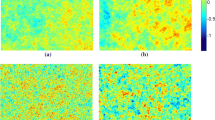Abstract
Structural characteristics of random field threshold exceedance sets (e.g., size, connectivity, and boundary regularity) are used in practice for definition of different indicators in spatial and spatio-temporal risk analysis. In this work, point process techniques are applied to study the structural changes derived from random field deformations and blurring transformations, meaningful from both physical and methodological points of view in a variety of contexts. Specifically, based on simulations from a flexible random field model class, features such as aggregation/inhibition of patterns defined by centroids of connected components, as well as by boundary A-exit points, are investigated in relation to the local contraction/dilation effects of deformation and the smoothing properties of blurring. Supplementary materials accompanying this paper appear online.












Similar content being viewed by others
References
Adler RJ (1981) The Geometry of Random Fields. Wiley, Chichester
—— (2008) Some new random field tools for spatial analysis. Stochastic Environmental Research and Risk Assessment 22: 802-822
Adler RJ, Taylor JE (2007) Random Fields and Geometry. Springer, New York
—— (2011) Topological Complexity of Smooth Random Functions. Lecture Notes in Mathematics, vol. 2019. Springer, Berlin Heidelberg
Amit Y, Grenander U, Piccioni M (1991) Structural image restoration through deformable templates. Journal of the American Statistical Association 86: 376-387
Anderes EB, Stein ML (2008) Estimating deformations of isotropic Gaussian random fields on the plane. The Annals of Statistics 36: 719-741
Angulo JM, Madrid AE (2010) Structural analysis of spatio-temporal threshold exceedances. Environmetrics 21: 415-438
——– (2014) A Deformation/Blurring-Based Spatio-Temporal Model Stochastic Environmental Research and Risk Assessment 28: 1061-1073
Baddeley AJ, Moller J, Waagepetersen R (2000). Non- and semi-parametric estimation of interaction in homogeneous point patterns. Statistica Neerlandica 54: 329-350
Banerjee S, Carlin BP, Gelfand AE, (2014, 2ed) Hierarchical Modeling and Analysis for Spatial Data. Chapman & Hall/CRC, Boca Raton
Brown PE, Karesen KF, Roberts GO, Tonellato S (2000) Blur-generated non-separable space-time models. Journal of the Royal Statistical Society, Series B 62: 847-860
Christensen GE, Rabbit RD, Miller MI (1996) Deformable templates using large deformation kinematics. IEEE Transations on Image Processing 5: 1435-1447
Clerc M, Mallat S (2003) Estimating deformations of stationary processes. Annals of Statistics 31: 1772-1821
Cox DR, Isham V (1980) Point Processes. Chapman & Hall, London.
Cressie N (1993) Statistics for Spatial Data. Wiley, New York
Daley DJ, Vere-Jones D (1988) An Introduction to the Theory of Point Processes. Springer, New York
—— (2003) An Introduction to the Theory of Point Processes. Volume I: Elementary Theory and Methods. Springer, New York
—— (2008) An Introduction to the Theory of Point Processes. Volume II: General Theory and Structure. Springer, New York
Diggle PJ (2014) Statistical Analysis of Spatial and Spatio-Temporal Point Patterns. Chapman & Hall/CRC, Boca Raton
Fouedjio F, Desassis N, Romary T (2015) Estimation of space deformation model for non-stationary random functions. Spatial Statistics 13: 45-61
Glasbey CA, Mardia KV (1998) A review of image warping methods. Journal of Applied Statistics 25: 155-171
——– (2001) A penalized likelihood approach to image warping. Journal of the Royal Statistical Society. Series B 63: 465-514
Gneiting T, Schlather M (2004) Stochastic models that separate fractal dimension and the Hurst effect. SIAM Review 46: 269-282
Goitía A, Ruiz-Medina MD, Angulo JM (2005) Joint estimation of spatial deformation and blurring in environmental data. Stochastic Environmental Research and Risk Assessment 19: 1-17
Madrid AE, Angulo JM, Mateu J (2012) Spatial threshold exceedance analysis through marked point processes. Environmetrics 23: 108-118
Mardia KV, Angulo JM, Goitía A (2006a) Synthesis of image deformation strategies. Image and Vision Computing 24: 1-12
Mardia KV, Bookstein FL, Kent JT, Meyer CR (2006b) Intrinsic random fields and image deformations. Journal of Mathematical Imaging and Vision 26: 59-71
Perrin O, Monestiez, P (1999) Modelling of non-stationary spatial structure using parametric radial basis deformation. In: geoENV II - Geostatistics for Environmental Applications, Gómez-Hernández, J (ed), 175-186. Springer, Dordrecht
Perrin O, Senoussi R (1999) Reducing non-stationary stochastic processes to stationary by a time deformation. Statistics & Probability Letters 43: 393-397
Reiss RD (1993) A Course on Point Processes. Springer, New York
Piterbarg VI (1996) Asymptotic Methods in the Theory of Gaussian Processes and Fields. American Mathematical Society, Providence
Ripley BD (1977) Modelling spatial patterns. Journal of the Royal Statistical Society, Series B 39: 172-212
Sampson PD, Guttorp P (1992) Nonparametric estimation of nonstationary spatial covariance structure. Journal of the American Statistical Association 87: 108-119
Storvik G, Frigessi A, Hirst D (2002) Stationary space-time Gaussian fields and their time autoregressive representation. Statistical Modelling 2: 139-161
Stoyan D, Kendall WS, Mecke J (1995) Stochastic Geometry and its Applications. Wiley, New York
van Lieshout MNM (2000) Marked Point Processes and Their Applications. Imperial College Press, London
VanMarcke E (2010) Random Fields: Analysis and Synthesis. World Scientific, Singapore
Vera JF, Angulo JM, Roldán JA (2016) Stability analysis in nonstationary spatial covariance estimation. Stochastic Environmental Research and Risk Assessment. doi:10.1007/s00477-016-1228-4
Acknowledgments
J.M. Angulo and A.E. Madrid have been partially supported by grants MTM2012-32666 and MTM2015-70840-P (MINECO/FEDER). J. Mateu has been partially supported by grants MTM2013-43917-P (MINECO/FEDER) and P1-1B2015-40.
Author information
Authors and Affiliations
Corresponding author
Rights and permissions
About this article
Cite this article
Madrid, A.E., Angulo, J.M. & Mateu, J. Point Pattern Analysis of Spatial Deformation and Blurring Effects on Exceedances. JABES 21, 512–530 (2016). https://doi.org/10.1007/s13253-016-0262-5
Received:
Accepted:
Published:
Issue Date:
DOI: https://doi.org/10.1007/s13253-016-0262-5




